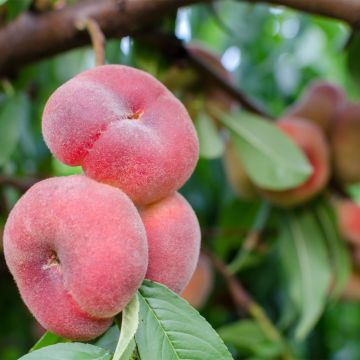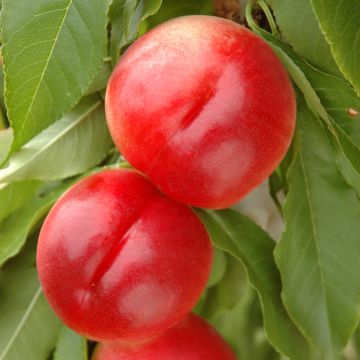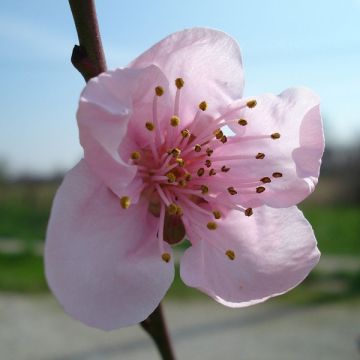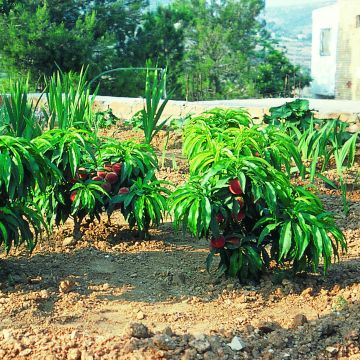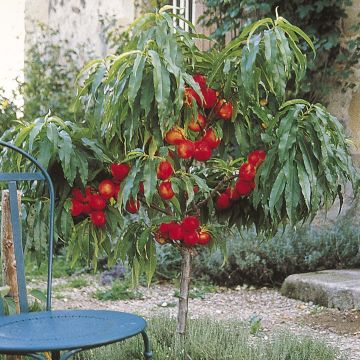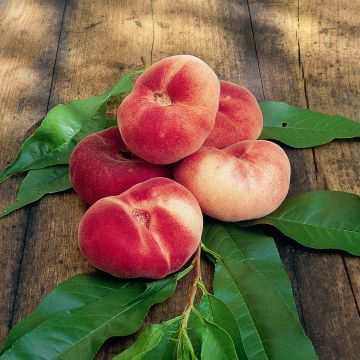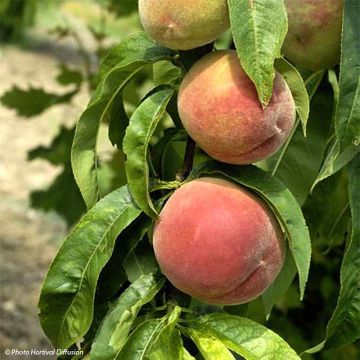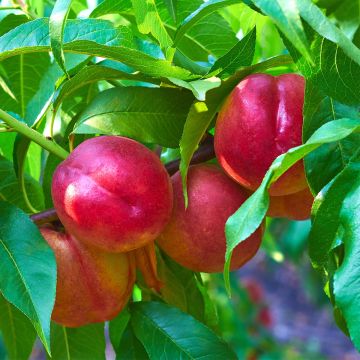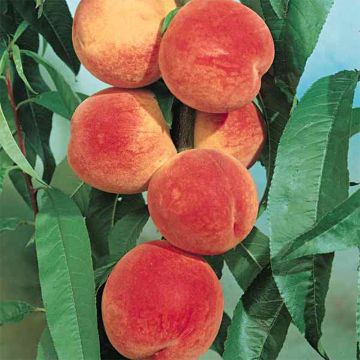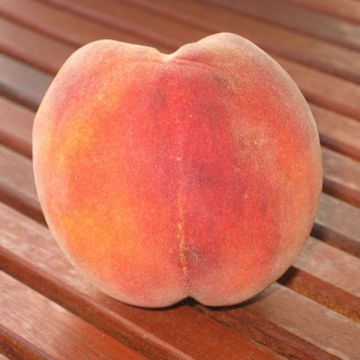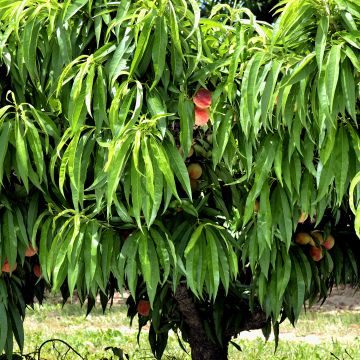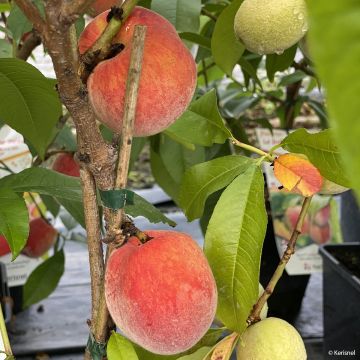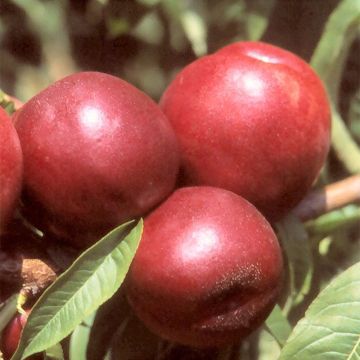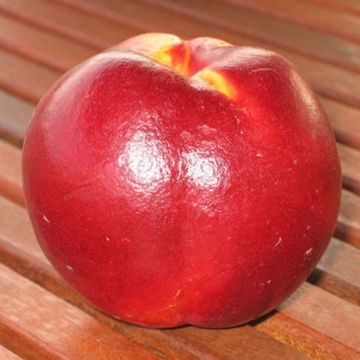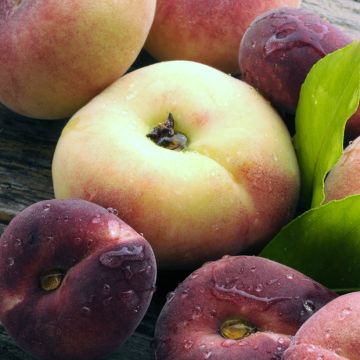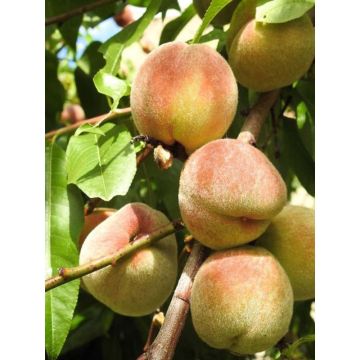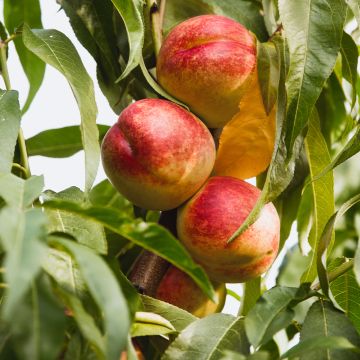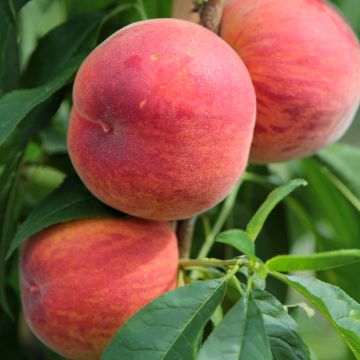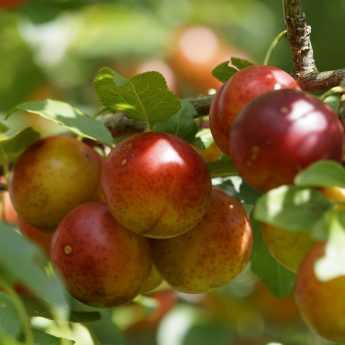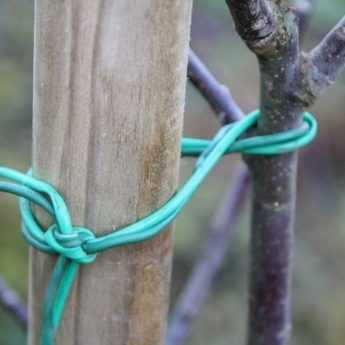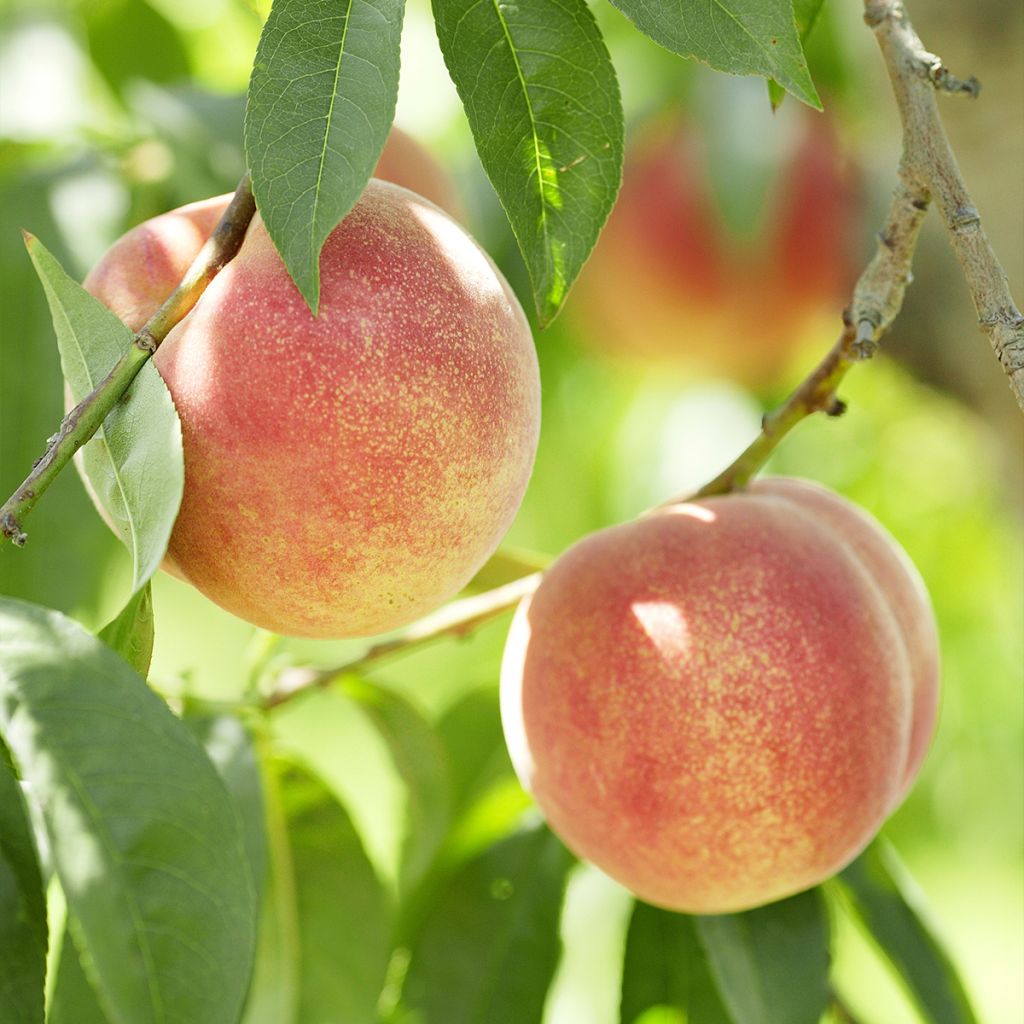

Prunus persica White Vine Peach - PEach Tree
Prunus persica White Vine Peach - PEach Tree
Prunus persica Vigne Blanche
Peach, Peach tree
Why not try an alternative variety in stock?
View all →This plant carries a 6 months recovery warranty
More information
We guarantee the quality of our plants for a full growing cycle, and will replace at our expense any plant that fails to recover under normal climatic and planting conditions.
Description
The White Vine Peach, Prunus persica, is a late-flowering variety that adapts well in most regions, including those with unexpected frosts in April. It is a vigorous, hardy, and self-fertile variety, resistant to peach leaf curl. It abundantly produces medium-sized fruits, rounded in shape, with a very fuzzy skin, yellow marbled with red on the sunny side. Its white flesh is melting, juicy, sweet, highly fragrant, and delicious. Harvest takes place in September, at the same time as grapes, and the fruits are consumed as they ripen.
Prunus persica (Common Peach) is a fruit tree belonging to the Rosaceae family, originating from China in the Sichuan and Guizhou regions around 500 BCE. It appeared in Europe in the 6th century and experienced significant development in the 19th century. From then on, numerous selections aimed at improving the fruit's taste qualities took place.
The White Vine Peach, as its name suggests, was once cultivated in vineyards. The presence of white spots on its leaves indicated the arrival of powdery mildew. Moreover, during the grape harvest, picking juicy peaches refreshed the harvesters. It is a small fruit tree with a fairly upright habit that can reach a height of 3 to 4 metres (10 to 13 feet), with a diameter of about 3 metres (10 feet). Its habit is well suited to low forms (goblet-shaped) or espaliers. Its foliage is composed of lanceolate leaves, 8 to 15 cm (3 to 6in) long and 3 to 4 cm (1 to 2in) wide, with serrated and embossed edges, bright green, turning yellow-orange in autumn before falling. The leaves have a slight almond scent. In April the pink flowers, 2 to 3 cm (1in) in diameter, appear solitarily, before the leaves on the previous year's branches. They can be destroyed by frost from -2 to -3 °C. It is remarkably decorative flowering in spring, and particularly rich in nectar and pollen. This variety is self-fertile, not requiring other peach trees nearby for pollination.
Prunus persica White Vine is a fertile variety with a quick fruiting time. Fruit harvesting begins in early September and continues throughout the month as the fruits ripen. Peaches, being very delicate, need to be handpicked with care. The fruits are consumed right after harvesting. They are of medium size, weighing between 150 and 180 grams, with a red skin speckled with yellow. Its yellow-orange flesh is melting, juicy, and sweet, of excellent taste quality. Tasty and delicious, peaches are eaten fresh right after picking. They are ideal for making compotes, ice creams and sorbets, tarts, pastries, fruit salads or compositions, as an accompaniment to savory meat dishes (duck, rabbit, chicken, etc.) or fish (salmon, cod, etc.). They are also perfect for making juices or fruits in syrup. Being rich in water, peaches refresh and quench thirst. They have a fleshy texture, providing a feeling of satiety. Low in calories, they are also rich in potassium, magnesium, and phosphorus, with a significant iron content. Their content of vitamins C and B, antioxidants, and fibre makes peaches a health asset. They are invigorating, energising, and rehydrating. The fruits can be stored for a week in a cool place, protected from light.
In the category of Peach and Nectarine Trees, the White Vine Peach is a variety known for the flavour of its fruits. It is resistant to peach leaf curl but may be susceptible to powdery mildew. Like many fruit trees, it prefers rich, deep, and well-drained soils. It prefers a sunny exposure, sheltered from draughts and cold winds. A southeast or southwest exposure is ideal. In regions that frequently experience late spring frosts, the peach tree can be trained against a south-facing wall. Very popular thanks to its fruit, the peach tree brings pleasure to young and old alike. With a wide range of varieties, it is easy to find the one that best suits your taste.
Report an error about the product description
Prunus persica White Vine Peach - PEach Tree in pictures
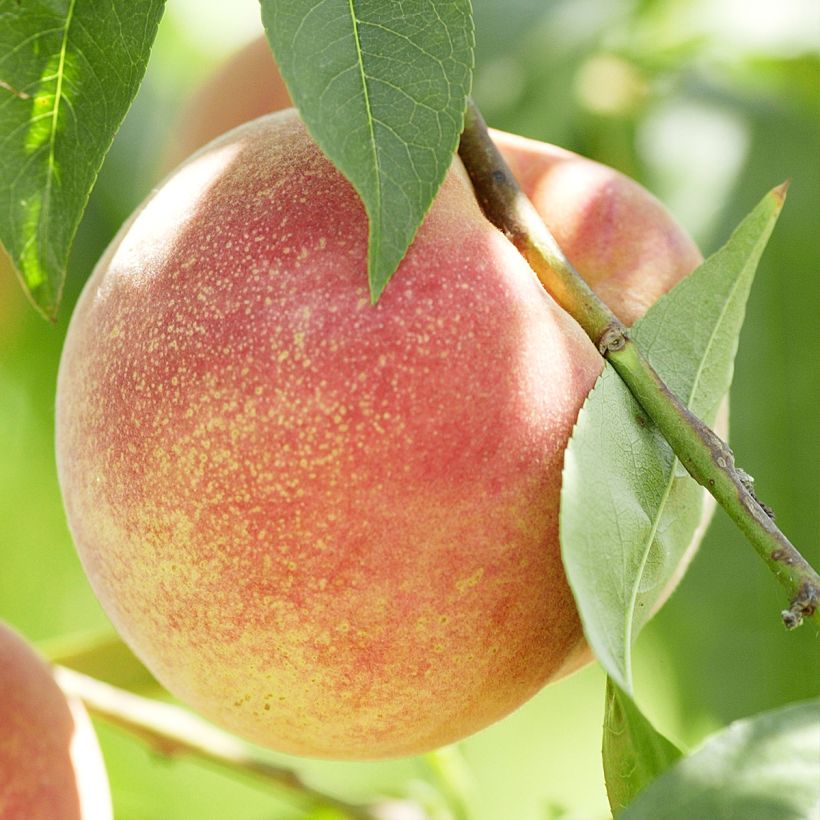

Plant habit
Fruit
Flowering
Foliage
Botanical data
Prunus
persica
Vigne Blanche
Rosaceae
Peach, Peach tree
Cultivar or hybrid
Other Peach and Nectarine trees
View all →Planting and care
The White Vine Peach should be planted in full sun, sheltered from draughts and cold winds. A southeast or southwest exposure is ideal. If you do not live in a very sunny climate, the peach tree can be trained against a south-facing wall. In regions that frequently experience late spring frosts, it will be more difficult, if not impossible, to get a peach tree to bear fruit.
It requires ordinary soil that is rich, deep, and well-drained. The peach tree dislikes heavy, waterlogged soils, as well as alkaline soils.
The planting period depends on the form of the peach tree. A bare-root peach tree should be planted from October to March, traditionally for Saint Catherine's Day, avoiding periods of frost. A bare-root fruit tree should be planted immediately after purchase, as the roots should not be exposed to the sun and open air. If you cannot plant it immediately, put it in temporary storage.
If purchased in a container, the peach tree can be planted in autumn, from October to December, again avoiding periods of frost, or even in spring.
Dig a hole at least 60 cm (24in) deep and 1 metre (3 feet) wide, at least one week before planting. Remove all stones and weeds. Place the container in a basin to moisten the root ball through capillary action. Add two handfuls of crushed horn at the bottom of the hole. Mix the excavated soil with well-rotted compost, well-decomposed manure, or potting soil. Fill the hole halfway with the excavated soil. Plant a stake at least 50 cm (20in) deep. Place the peach tree in the hole. Fill with the remaining soil. Gently compact the soil around the peach tree and secure it to the stake. Form a depression in the soil around the base and water abundantly.
Proceed in the same manner if you are planting a bare-root peach tree, but do not forget to dress and prune the bare roots before planting.
Planting period
Intended location
Care
Planting & care advice
This item has not been reviewed yet - be the first to leave a review about it.
Haven't found what you were looking for?
Hardiness is the lowest winter temperature a plant can endure without suffering serious damage or even dying. However, hardiness is affected by location (a sheltered area, such as a patio), protection (winter cover) and soil type (hardiness is improved by well-drained soil).

Photo Sharing Terms & Conditions
In order to encourage gardeners to interact and share their experiences, Promesse de fleurs offers various media enabling content to be uploaded onto its Site - in particular via the ‘Photo sharing’ module.
The User agrees to refrain from:
- Posting any content that is illegal, prejudicial, insulting, racist, inciteful to hatred, revisionist, contrary to public decency, that infringes on privacy or on the privacy rights of third parties, in particular the publicity rights of persons and goods, intellectual property rights, or the right to privacy.
- Submitting content on behalf of a third party;
- Impersonate the identity of a third party and/or publish any personal information about a third party;
In general, the User undertakes to refrain from any unethical behaviour.
All Content (in particular text, comments, files, images, photos, videos, creative works, etc.), which may be subject to property or intellectual property rights, image or other private rights, shall remain the property of the User, subject to the limited rights granted by the terms of the licence granted by Promesse de fleurs as stated below. Users are at liberty to publish or not to publish such Content on the Site, notably via the ‘Photo Sharing’ facility, and accept that this Content shall be made public and freely accessible, notably on the Internet.
Users further acknowledge, undertake to have ,and guarantee that they hold all necessary rights and permissions to publish such material on the Site, in particular with regard to the legislation in force pertaining to any privacy, property, intellectual property, image, or contractual rights, or rights of any other nature. By publishing such Content on the Site, Users acknowledge accepting full liability as publishers of the Content within the meaning of the law, and grant Promesse de fleurs, free of charge, an inclusive, worldwide licence for the said Content for the entire duration of its publication, including all reproduction, representation, up/downloading, displaying, performing, transmission, and storage rights.
Users also grant permission for their name to be linked to the Content and accept that this link may not always be made available.
By engaging in posting material, Users consent to their Content becoming automatically accessible on the Internet, in particular on other sites and/or blogs and/or web pages of the Promesse de fleurs site, including in particular social pages and the Promesse de fleurs catalogue.
Users may secure the removal of entrusted content free of charge by issuing a simple request via our contact form.
The flowering period indicated on our website applies to countries and regions located in USDA zone 8 (France, the United Kingdom, Ireland, the Netherlands, etc.)
It will vary according to where you live:
- In zones 9 to 10 (Italy, Spain, Greece, etc.), flowering will occur about 2 to 4 weeks earlier.
- In zones 6 to 7 (Germany, Poland, Slovenia, and lower mountainous regions), flowering will be delayed by 2 to 3 weeks.
- In zone 5 (Central Europe, Scandinavia), blooming will be delayed by 3 to 5 weeks.
In temperate climates, pruning of spring-flowering shrubs (forsythia, spireas, etc.) should be done just after flowering.
Pruning of summer-flowering shrubs (Indian Lilac, Perovskia, etc.) can be done in winter or spring.
In cold regions as well as with frost-sensitive plants, avoid pruning too early when severe frosts may still occur.
The planting period indicated on our website applies to countries and regions located in USDA zone 8 (France, United Kingdom, Ireland, Netherlands).
It will vary according to where you live:
- In Mediterranean zones (Marseille, Madrid, Milan, etc.), autumn and winter are the best planting periods.
- In continental zones (Strasbourg, Munich, Vienna, etc.), delay planting by 2 to 3 weeks in spring and bring it forward by 2 to 4 weeks in autumn.
- In mountainous regions (the Alps, Pyrenees, Carpathians, etc.), it is best to plant in late spring (May-June) or late summer (August-September).
The harvesting period indicated on our website applies to countries and regions in USDA zone 8 (France, England, Ireland, the Netherlands).
In colder areas (Scandinavia, Poland, Austria...) fruit and vegetable harvests are likely to be delayed by 3-4 weeks.
In warmer areas (Italy, Spain, Greece, etc.), harvesting will probably take place earlier, depending on weather conditions.
The sowing periods indicated on our website apply to countries and regions within USDA Zone 8 (France, UK, Ireland, Netherlands).
In colder areas (Scandinavia, Poland, Austria...), delay any outdoor sowing by 3-4 weeks, or sow under glass.
In warmer climes (Italy, Spain, Greece, etc.), bring outdoor sowing forward by a few weeks.


































